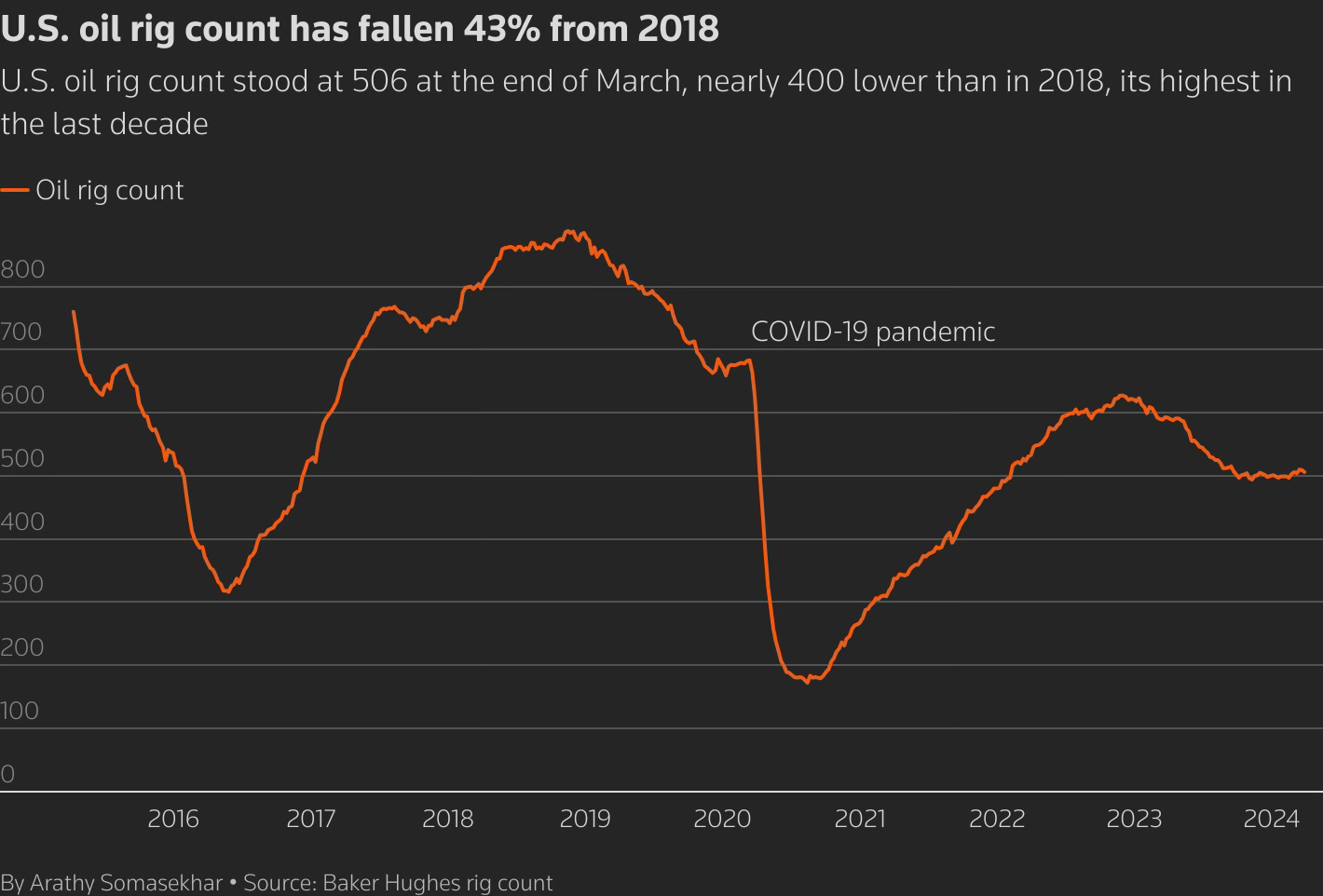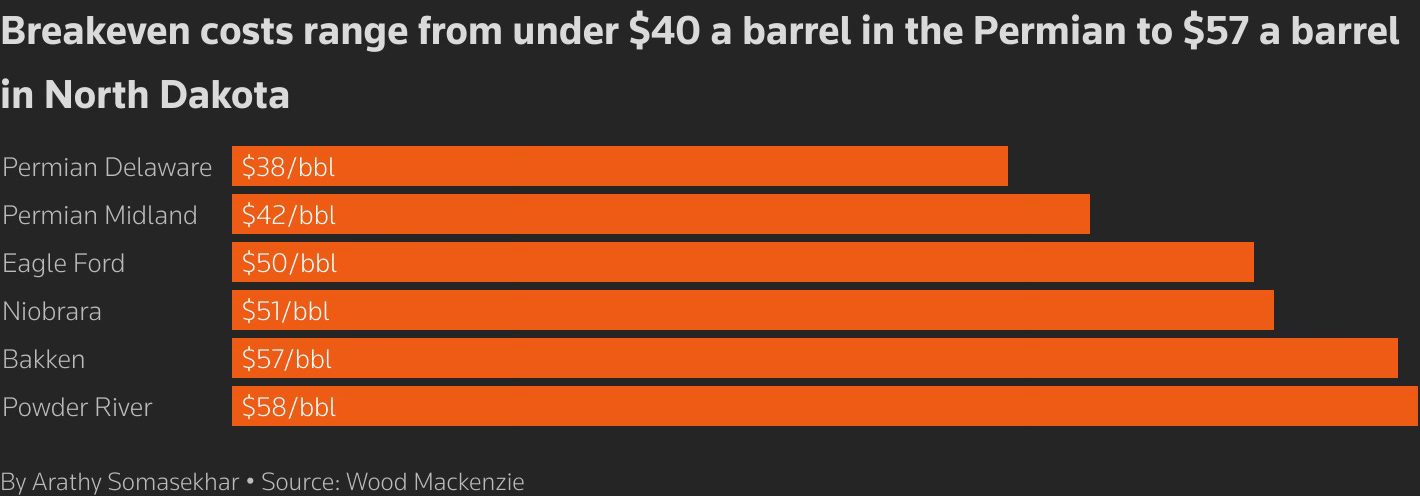Upstream Intel 4/14/25
Preparing for sub-$60 oil | Strategic land competences | Abu Dhabi buys stake in Kimmeridge | Interior ends environment reviews for leases | Chevron expands 'triple frac' use
Welcome back to Upstream Intel, Lease Analytics’ weekly roundup of our analysis and insights. As always, we would love to hear from you with news ideas, feedback and anything else you find interesting.
Sent this by a friend? Sign up here to receive UIW in your inbox.
Data Drill: Macro environment creates production tensions

Trade tensions and demand hits rattle shale players
Global trade tensions have triggered a steep oil price decline, with WTI crude plummeting from $75 in January to below $60 per barrel currently—well beneath the $65 breakeven threshold many shale producers require for profitable drilling. The trade policy-driven price drop has been exacerbated by OPEC+'s acceleration of production increases and falling demand forecasts, blindsiding many operators.
Industry executives warn that sustained sub-$60 oil would force significant reductions in drilling activity, potentially leading to production declines, as early as this year rather than the previously projected 2026 timeframe. Smaller producers, with higher-cost acreage in basins like the Powder River, will likely curtail operations first, while even Permian operators face challenging economics.
Industry frustration is growing, with Diamondback Energy's president publicly challenging the administration on social media, noting that oil and gas is "the only industry that actually built itself in the U.S., manufactures in the U.S., grew jobs in the U.S. and improved the trade deficit."
…yet calls to cut production ring hollow
Despite appeals to "cut immediately and hunker down," many producers are maintaining aggressive growth plans despite market turmoil.
U.S. Energy Development Corporation still plans to deploy $1 billion across multiple projects this year, up from $800 million in 2024, with CEO Jordan Jayson emphasizing that "we have a saying where we need to always act as if it was $35 oil." Similarly, newly public Infinity Natural Resources expects to increase production by 44% in 2025, while actively pursuing acquisition opportunities in Ohio's expanding Utica oil play.
“These global macro headlines and market volatility really don't affect how we manage the company on a day-to-day basis."
— Jordan Jayson, CEO of U.S. Energy Development Corporation
The disconnect between alarmist articles and operational reality hints at how many producers are better positioned to weather this downturn than in previous cycles. While some companies are making tactical adjustments - slightly choking back production or shifting focus to their most productive assets - the widespread production cuts that characterized previous downturns have yet to materialize.
This resilience reflects both improved financial discipline since the COVID collapse of 2020 and substantial consolidation that has concentrated assets in the hands of operators with stronger balance sheets. For now, most producers appear content to adjust rather than abandon their growth trajectories, potentially seizing market share from more vulnerable peers as the cycle unfolds.
Land management takes a larger role in E&P strategy
For the leadership teams focused more on competitive positioning than macro noise, land management is moving from a back office function to of criterial strategic concern. From Ring Energy’s bet on becoming the apex consolidation in the Central Basin Platform to Exxon’s long game in the Haynesville, strong land competencies are emerging as a critical edge in the shale endgame. In a maturing resource landscape, portfolio positioning and land discipline may matter more than drilling speed.
Read more on how E&Ps are reprioritizing land strategy on Lease-Analytics.com
‘Lawfare’ in U.S. Energy Policy
Regulatory fights heat up between levels of government
The Trump administration has launched a direct assault on state regulations through executive order directing Attorney General Bondi to halt enforcement of state climate laws deemed unconstitutional. “Protecting American Energy from State Overreach” effectively initiates what many analysts describe as "lawfare" – the strategic use of legal systems and institutions to achieve policy objectives which otherwise face legislative obstacles.
The deregulatory campaign accelerated with Interior's announcement eliminating environmental impact statement requirements for over 3,200 oil and gas leases (more below). Simultaneously, the presidential memorandum instructs federal agencies to bypass public notice-and-comment processes when repealing regulations inconsistent with administration priorities, claiming legal justification from recent Supreme Court decisions.
While industry groups have praised the actions, Democratic governors vow resistance, declaring "the federal government cannot unilaterally strip states' independent constitutional authority." Legal experts anticipate protracted litigation that may benefit well-capitalized operators able to navigate the complex regulatory environment, while smaller players struggle with competing compliance demands from different levels of government.
US drops green analysis on thousands of legacy leases
The U.S. Interior Department announced it will no longer require environmental impact statements for approximately 3,244 oil and gas leases across seven western states, reversing a Biden administration decision from January 16. The affected leases, which had been the target of litigation by environmental groups, cover Colorado, Montana, New Mexico, North Dakota, South Dakota, Utah, and Wyoming.
The move is a victory for the oil and gas industry and continues the administration's aggressive rollback of environmental review requirements. The Interior Department stated that while environmental impact statements would no longer be required, the Bureau of Land Management remains "evaluating options for compliance" with environmental regulations for these leasing decisions.
In Other News:
Gulf money scoops up US gas assets
Abu Dhabi is increasing its investment in the US natural gas sector as Donald Trump's administration reignites hopes for an energy boom. Mubadala Energy, owned by Abu Dhabi's sovereign wealth fund, has acquired a 24.1% stake in Kimmeridge's Texas gas production business and Commonwealth LNG export terminal in Louisiana.
The investment, reportedly worth hundreds of millions of dollars, comes as Middle Eastern firms are increasingly targeting US shale gas assets to secure positions in the global LNG market, with analysts projecting the US will supply about a third of the world's LNG by 2050.
Downstream concerns could affect the whole sector
This newsletter rarely ventures into downstream territory—it's in the name, after all—but recent hollowing out of downstream capacity merits broader attention. Despite above trend refining profits, operators are increasingly closing facilities, unwilling to invest billions in modernizing or new facilities to process U.S. light crude.
The hollowing out of U.S. refining comes as the Trump administration is investing in supply chain security via domestic refining in critical minerals, pharmaceutics, and biotechnology. But as the emphasis on secure advanced refining advances through the lens of geoeconomic competition with China, we should not forget the apparently overlooked security relevance of oil refineries.
Chevron to use ‘triple-frac’ method on half of all permian wells
Chevron plans to increasing its usage of "triple-frac" — fracturing three wells simultaneously with a single frac spread — from 20% to over 50% of Permian wells in 2025. As Chevron seeks efficiency gains amid falling crude prices, triple-frac reduces well completion time by 25% and cuts costs per well by 12%, according to completions operations manager Jeff Newhook.
While requiring 60% more water and sand delivered daily, plus more upfront capital for drilling—the approach allows Chevron to accelerate production timelines and optimize ROI.
Stat of the Week:
8%
The expected American 2025 output reduction with sustained $50 oil.
What We’re Reading:
Iron Oak Energy Expands in Permian with High Roller Sand Deal. (Hart Energy)
Matador Resources sells remaining Eagle Ford shale assets for $30m. (Offshore Technology)
EU weighs up buying more US gas due to Donald Trump tariff pressure. (Financial Times)
US Bonds, Dollar Battered as ‘Sell America’ Trade Heats Up. (EnergyNow)
Elevation Resources enters Permian development partnership with IOG Resources II. (Oil and Gas Journal)
Job Numbers Rise in Alaska’s Arctic Thanks to Oil Projects. (Oilprice.com)
Kathleen Sgamma withdrew her nomination to lead the Bureau of Land Management. (E&E News)
Permitting Outreach Efforts Land in Unusual Hands. (Hart Energy)
US Plans to Develop AI Projects on Energy Department Lands. (Reuters)




